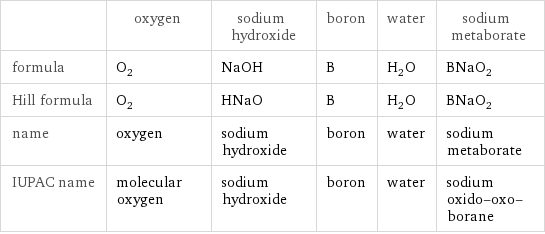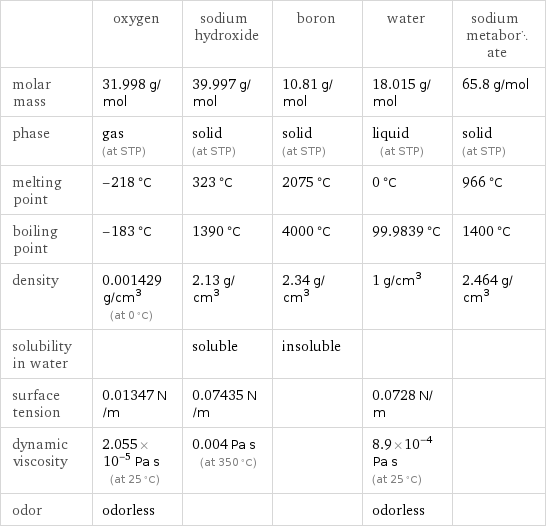Input interpretation

O_2 oxygen + NaOH sodium hydroxide + B boron ⟶ H_2O water + BNaO_2 sodium metaborate
Balanced equation

Balance the chemical equation algebraically: O_2 + NaOH + B ⟶ H_2O + BNaO_2 Add stoichiometric coefficients, c_i, to the reactants and products: c_1 O_2 + c_2 NaOH + c_3 B ⟶ c_4 H_2O + c_5 BNaO_2 Set the number of atoms in the reactants equal to the number of atoms in the products for O, H, Na and B: O: | 2 c_1 + c_2 = c_4 + 2 c_5 H: | c_2 = 2 c_4 Na: | c_2 = c_5 B: | c_3 = c_5 Since the coefficients are relative quantities and underdetermined, choose a coefficient to set arbitrarily. To keep the coefficients small, the arbitrary value is ordinarily one. For instance, set c_4 = 1 and solve the system of equations for the remaining coefficients: c_1 = 3/2 c_2 = 2 c_3 = 2 c_4 = 1 c_5 = 2 Multiply by the least common denominator, 2, to eliminate fractional coefficients: c_1 = 3 c_2 = 4 c_3 = 4 c_4 = 2 c_5 = 4 Substitute the coefficients into the chemical reaction to obtain the balanced equation: Answer: | | 3 O_2 + 4 NaOH + 4 B ⟶ 2 H_2O + 4 BNaO_2
Structures

+ + ⟶ +
Names

oxygen + sodium hydroxide + boron ⟶ water + sodium metaborate
Reaction thermodynamics
Enthalpy

| oxygen | sodium hydroxide | boron | water | sodium metaborate molecular enthalpy | 0 kJ/mol | -425.8 kJ/mol | 0 kJ/mol | -285.8 kJ/mol | -977 kJ/mol total enthalpy | 0 kJ/mol | -1703 kJ/mol | 0 kJ/mol | -571.7 kJ/mol | -3908 kJ/mol | H_initial = -1703 kJ/mol | | | H_final = -4480 kJ/mol | ΔH_rxn^0 | -4480 kJ/mol - -1703 kJ/mol = -2776 kJ/mol (exothermic) | | | |
Equilibrium constant
![Construct the equilibrium constant, K, expression for: O_2 + NaOH + B ⟶ H_2O + BNaO_2 Plan: • Balance the chemical equation. • Determine the stoichiometric numbers. • Assemble the activity expression for each chemical species. • Use the activity expressions to build the equilibrium constant expression. Write the balanced chemical equation: 3 O_2 + 4 NaOH + 4 B ⟶ 2 H_2O + 4 BNaO_2 Assign stoichiometric numbers, ν_i, using the stoichiometric coefficients, c_i, from the balanced chemical equation in the following manner: ν_i = -c_i for reactants and ν_i = c_i for products: chemical species | c_i | ν_i O_2 | 3 | -3 NaOH | 4 | -4 B | 4 | -4 H_2O | 2 | 2 BNaO_2 | 4 | 4 Assemble the activity expressions accounting for the state of matter and ν_i: chemical species | c_i | ν_i | activity expression O_2 | 3 | -3 | ([O2])^(-3) NaOH | 4 | -4 | ([NaOH])^(-4) B | 4 | -4 | ([B])^(-4) H_2O | 2 | 2 | ([H2O])^2 BNaO_2 | 4 | 4 | ([BNaO2])^4 The equilibrium constant symbol in the concentration basis is: K_c Mulitply the activity expressions to arrive at the K_c expression: Answer: | | K_c = ([O2])^(-3) ([NaOH])^(-4) ([B])^(-4) ([H2O])^2 ([BNaO2])^4 = (([H2O])^2 ([BNaO2])^4)/(([O2])^3 ([NaOH])^4 ([B])^4)](../image_source/2ef24d00545ecaf4e62dfd6bc6ffa106.png)
Construct the equilibrium constant, K, expression for: O_2 + NaOH + B ⟶ H_2O + BNaO_2 Plan: • Balance the chemical equation. • Determine the stoichiometric numbers. • Assemble the activity expression for each chemical species. • Use the activity expressions to build the equilibrium constant expression. Write the balanced chemical equation: 3 O_2 + 4 NaOH + 4 B ⟶ 2 H_2O + 4 BNaO_2 Assign stoichiometric numbers, ν_i, using the stoichiometric coefficients, c_i, from the balanced chemical equation in the following manner: ν_i = -c_i for reactants and ν_i = c_i for products: chemical species | c_i | ν_i O_2 | 3 | -3 NaOH | 4 | -4 B | 4 | -4 H_2O | 2 | 2 BNaO_2 | 4 | 4 Assemble the activity expressions accounting for the state of matter and ν_i: chemical species | c_i | ν_i | activity expression O_2 | 3 | -3 | ([O2])^(-3) NaOH | 4 | -4 | ([NaOH])^(-4) B | 4 | -4 | ([B])^(-4) H_2O | 2 | 2 | ([H2O])^2 BNaO_2 | 4 | 4 | ([BNaO2])^4 The equilibrium constant symbol in the concentration basis is: K_c Mulitply the activity expressions to arrive at the K_c expression: Answer: | | K_c = ([O2])^(-3) ([NaOH])^(-4) ([B])^(-4) ([H2O])^2 ([BNaO2])^4 = (([H2O])^2 ([BNaO2])^4)/(([O2])^3 ([NaOH])^4 ([B])^4)
Rate of reaction
![Construct the rate of reaction expression for: O_2 + NaOH + B ⟶ H_2O + BNaO_2 Plan: • Balance the chemical equation. • Determine the stoichiometric numbers. • Assemble the rate term for each chemical species. • Write the rate of reaction expression. Write the balanced chemical equation: 3 O_2 + 4 NaOH + 4 B ⟶ 2 H_2O + 4 BNaO_2 Assign stoichiometric numbers, ν_i, using the stoichiometric coefficients, c_i, from the balanced chemical equation in the following manner: ν_i = -c_i for reactants and ν_i = c_i for products: chemical species | c_i | ν_i O_2 | 3 | -3 NaOH | 4 | -4 B | 4 | -4 H_2O | 2 | 2 BNaO_2 | 4 | 4 The rate term for each chemical species, B_i, is 1/ν_i(Δ[B_i])/(Δt) where [B_i] is the amount concentration and t is time: chemical species | c_i | ν_i | rate term O_2 | 3 | -3 | -1/3 (Δ[O2])/(Δt) NaOH | 4 | -4 | -1/4 (Δ[NaOH])/(Δt) B | 4 | -4 | -1/4 (Δ[B])/(Δt) H_2O | 2 | 2 | 1/2 (Δ[H2O])/(Δt) BNaO_2 | 4 | 4 | 1/4 (Δ[BNaO2])/(Δt) (for infinitesimal rate of change, replace Δ with d) Set the rate terms equal to each other to arrive at the rate expression: Answer: | | rate = -1/3 (Δ[O2])/(Δt) = -1/4 (Δ[NaOH])/(Δt) = -1/4 (Δ[B])/(Δt) = 1/2 (Δ[H2O])/(Δt) = 1/4 (Δ[BNaO2])/(Δt) (assuming constant volume and no accumulation of intermediates or side products)](../image_source/d8431fa5896911a8b5cc1a6485a073dd.png)
Construct the rate of reaction expression for: O_2 + NaOH + B ⟶ H_2O + BNaO_2 Plan: • Balance the chemical equation. • Determine the stoichiometric numbers. • Assemble the rate term for each chemical species. • Write the rate of reaction expression. Write the balanced chemical equation: 3 O_2 + 4 NaOH + 4 B ⟶ 2 H_2O + 4 BNaO_2 Assign stoichiometric numbers, ν_i, using the stoichiometric coefficients, c_i, from the balanced chemical equation in the following manner: ν_i = -c_i for reactants and ν_i = c_i for products: chemical species | c_i | ν_i O_2 | 3 | -3 NaOH | 4 | -4 B | 4 | -4 H_2O | 2 | 2 BNaO_2 | 4 | 4 The rate term for each chemical species, B_i, is 1/ν_i(Δ[B_i])/(Δt) where [B_i] is the amount concentration and t is time: chemical species | c_i | ν_i | rate term O_2 | 3 | -3 | -1/3 (Δ[O2])/(Δt) NaOH | 4 | -4 | -1/4 (Δ[NaOH])/(Δt) B | 4 | -4 | -1/4 (Δ[B])/(Δt) H_2O | 2 | 2 | 1/2 (Δ[H2O])/(Δt) BNaO_2 | 4 | 4 | 1/4 (Δ[BNaO2])/(Δt) (for infinitesimal rate of change, replace Δ with d) Set the rate terms equal to each other to arrive at the rate expression: Answer: | | rate = -1/3 (Δ[O2])/(Δt) = -1/4 (Δ[NaOH])/(Δt) = -1/4 (Δ[B])/(Δt) = 1/2 (Δ[H2O])/(Δt) = 1/4 (Δ[BNaO2])/(Δt) (assuming constant volume and no accumulation of intermediates or side products)
Chemical names and formulas

| oxygen | sodium hydroxide | boron | water | sodium metaborate formula | O_2 | NaOH | B | H_2O | BNaO_2 Hill formula | O_2 | HNaO | B | H_2O | BNaO_2 name | oxygen | sodium hydroxide | boron | water | sodium metaborate IUPAC name | molecular oxygen | sodium hydroxide | boron | water | sodium oxido-oxo-borane
Substance properties

| oxygen | sodium hydroxide | boron | water | sodium metaborate molar mass | 31.998 g/mol | 39.997 g/mol | 10.81 g/mol | 18.015 g/mol | 65.8 g/mol phase | gas (at STP) | solid (at STP) | solid (at STP) | liquid (at STP) | solid (at STP) melting point | -218 °C | 323 °C | 2075 °C | 0 °C | 966 °C boiling point | -183 °C | 1390 °C | 4000 °C | 99.9839 °C | 1400 °C density | 0.001429 g/cm^3 (at 0 °C) | 2.13 g/cm^3 | 2.34 g/cm^3 | 1 g/cm^3 | 2.464 g/cm^3 solubility in water | | soluble | insoluble | | surface tension | 0.01347 N/m | 0.07435 N/m | | 0.0728 N/m | dynamic viscosity | 2.055×10^-5 Pa s (at 25 °C) | 0.004 Pa s (at 350 °C) | | 8.9×10^-4 Pa s (at 25 °C) | odor | odorless | | | odorless |
Units
